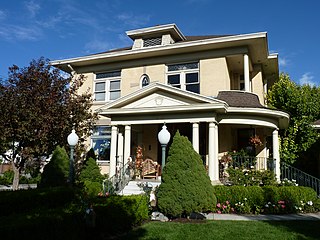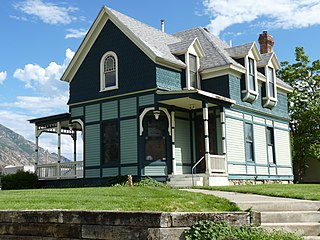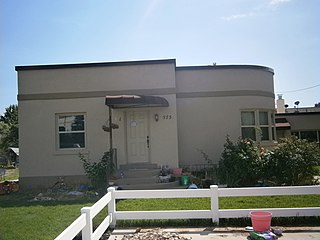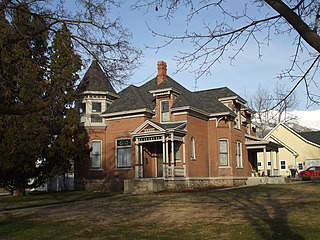
The Henry J. Wheeler Farm is a farmstead in Murray, Utah, United States, that is one of the few remaining late 19th century farmsteads in the Salt Lake Valley that has not been lost to expanding housing developments of metropolitan Salt Lake City. It has been listed on the National Register of Historic Places since 1976.

The Harvey H. Cluff house is a house in central Provo, Utah, United States, built in 1877 that is on the National Register of Historic Places. It was originally owned by Harvey H. Cluff.
Richard Karl August Kletting was an influential architect in Utah. He designed many well-known buildings, including the Utah State Capitol, the Enos Wall Mansion, the original Salt Palace, and the original Saltair Resort Pavilion. His design for the Utah State Capitol was chosen over 40 competing designs. A number of his buildings survive and are listed on the U.S. National Register of Historic Places including many in University of Utah Circle and in the Salt Lake City Warehouse District.

The Thomas N. Taylor House is a historic house located at 342 North 500 West in Provo, Utah. It is listed on the National Register of Historic Places.

The William D. Alexander House is a historic house located in Provo, Utah. It is listed on the National Register of Historic Places. It is asserted to be the only period example of Stick Style architecture in the state of Utah.

Silver Row is a historic site located in Provo, Utah. It is listed on the National Register of Historic Places.

The George M. Brown House is a historic residence in Provo, Utah, United States, that is listed on the National Register of Historic Places. It was built as a home for a "polygamous wife" of lawyer George M. Brown. It is listed on the National Register of Historic Places.

The George Angus and Martha Ansil Beebe House is a historic house located in Provo, Utah, United States. It is listed on the National Register of Historic Places.

The Charles E. Davies House is a historic house located in Provo, Utah. It is listed on the National Register of Historic Places.

The Superintendent's Residence at the Utah State Hospital is a historic house located at the Utah State Hospital in east Provo, Utah, United States. It was listed on the National Register of Historic Places in 1986.

The Francis Armstrong House is a historic house in Salt Lake City, Utah. It is locally significant as a fine example of Queen Anne style architecture.

The George and Temperance Adams House is a historic house located in Orem, Utah, United States.

The Carter–Terry–Call House is a historic residence in Orem, Utah, United States, that is listed on the National Register of Historic Places (NRHP).

The Cecil I. and Mildred H. Dimick House at 575 West 800 North in Orem, Utah was built in 1946. It was listed on the National Register of Historic Places in 1998.
The Henry C. Gale House at 495 N. 1st East, Beaver, Utah was built in 1889, of pink rock. It has had three additions since its construction. It is believed to have been built by local Scots stonemason Alexander Boyter. It was listed on the National Register of Historic Places in 1983.
The John T. and Henry T. Reynolds Jr. House is a historic residence within the Springville Historic District in Springville, Utah, United States, that is listed on the National Register of Historic Places (NRHP).

The Emanuel Kahn House, at 678 E. South Temple St. in Salt Lake City, Utah, is a Queen Anne house that was built in 1889. It was listed on the National Register of Historic Places in 1977.

The Richard Vaughen Morris House is a historic house located at 314 Quince Street in Salt Lake City, Utah, was built in the 1860s, definitely by 1866. It was listed on the National Register of Historic Places in 1980.

The Henry Blood House is a historic house in Kaysville, Utah, United States, that is listed on the National Register of Historic Places (NRHP).

The Dr. Lewis Condict House is a historic house located at 51 South Street in Morristown of Morris County, New Jersey. Built in 1797, it was added to the National Register of Historic Places on April 3, 1973, for its significance in architecture and health/medicine. In 1937, the Woman's Club of Morristown purchased the house for its headquarters. The house was added as a contributing property to the Morristown District on October 30, 1973.




















